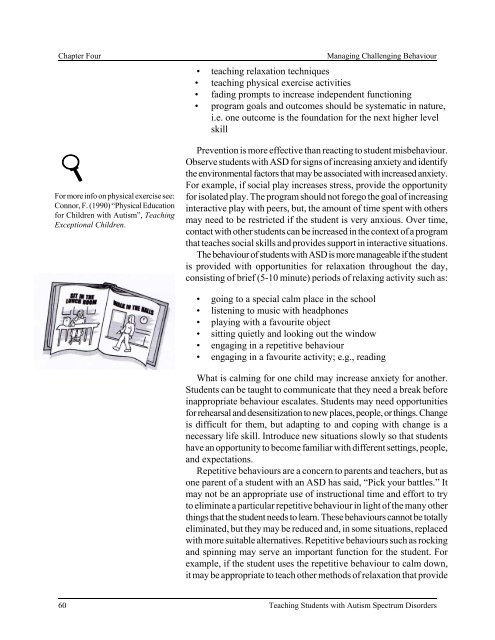Teaching Students with Autism Spectrum Disorders
Teaching Students with Autism Spectrum Disorders
Teaching Students with Autism Spectrum Disorders
Create successful ePaper yourself
Turn your PDF publications into a flip-book with our unique Google optimized e-Paper software.
Chapter Four Managing Challenging Behaviour<br />
For more info on physical exercise see:<br />
Connor, F. (1990) “Physical Education<br />
for Children <strong>with</strong> <strong>Autism</strong>”, <strong>Teaching</strong><br />
Exceptional Children.<br />
• teaching relaxation techniques<br />
• teaching physical exercise activities<br />
• fading prompts to increase independent functioning<br />
• program goals and outcomes should be systematic in nature,<br />
i.e. one outcome is the foundation for the next higher level<br />
skill<br />
Prevention is more effective than reacting to student misbehaviour.<br />
Observe students <strong>with</strong> ASD for signs of increasing anxiety and identify<br />
the environmental factors that may be associated <strong>with</strong> increased anxiety.<br />
For example, if social play increases stress, provide the opportunity<br />
for isolated play. The program should not forego the goal of increasing<br />
interactive play <strong>with</strong> peers, but, the amount of time spent <strong>with</strong> others<br />
may need to be restricted if the student is very anxious. Over time,<br />
contact <strong>with</strong> other students can be increased in the context of a program<br />
that teaches social skills and provides support in interactive situations.<br />
The behaviour of students <strong>with</strong> ASD is more manageable if the student<br />
is provided <strong>with</strong> opportunities for relaxation throughout the day,<br />
consisting of brief (5-10 minute) periods of relaxing activity such as:<br />
• going to a special calm place in the school<br />
• listening to music <strong>with</strong> headphones<br />
• playing <strong>with</strong> a favourite object<br />
• sitting quietly and looking out the window<br />
• engaging in a repetitive behaviour<br />
• engaging in a favourite activity; e.g., reading<br />
What is calming for one child may increase anxiety for another.<br />
<strong>Students</strong> can be taught to communicate that they need a break before<br />
inappropriate behaviour escalates. <strong>Students</strong> may need opportunities<br />
for rehearsal and desensitization to new places, people, or things. Change<br />
is difficult for them, but adapting to and coping <strong>with</strong> change is a<br />
necessary life skill. Introduce new situations slowly so that students<br />
have an opportunity to become familiar <strong>with</strong> different settings, people,<br />
and expectations.<br />
Repetitive behaviours are a concern to parents and teachers, but as<br />
one parent of a student <strong>with</strong> an ASD has said, “Pick your battles.” It<br />
may not be an appropriate use of instructional time and effort to try<br />
to eliminate a particular repetitive behaviour in light of the many other<br />
things that the student needs to learn. These behaviours cannot be totally<br />
eliminated, but they may be reduced and, in some situations, replaced<br />
<strong>with</strong> more suitable alternatives. Repetitive behaviours such as rocking<br />
and spinning may serve an important function for the student. For<br />
example, if the student uses the repetitive behaviour to calm down,<br />
it may be appropriate to teach other methods of relaxation that provide<br />
60 <strong>Teaching</strong> <strong>Students</strong> <strong>with</strong> <strong>Autism</strong> <strong>Spectrum</strong> <strong>Disorders</strong>

















